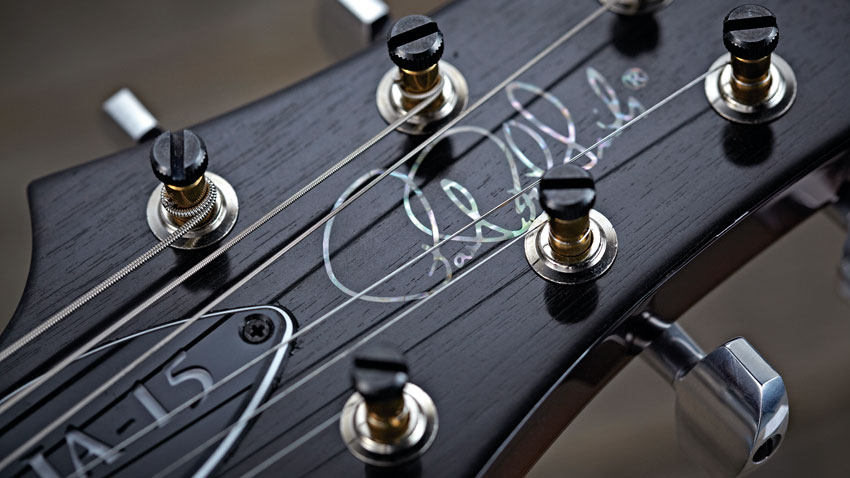MusicRadar Verdict
The oldest, jazziest-sounding PRS Hollowbody to date. For a compact, modern archtop, we've not heard better.
Pros
- +
A stylish, versatile guitar that plays and sounds fantastic.
Cons
- -
Lack of options: we'd like to see it 'Stripped'.
MusicRadar's got your back

PRS JA-15

Bridge

Body

Headstock
With more than a nod to the jazzers in our guitar-playing community, PRS has crafted a sumptuous semi acoustic in the JA-15.
In looks, the JA-15 seems to hark back to the hollowbody archtop. It's fairly big, measuring 382mm (15 inches) across its lower bouts and it's deeper, too, with the rim measuring 60.6mm (2.39 inches). In terms of overall depth, measured by the bridge the JA-15 is a stately 79mm (3.11 inches).
"The visual appearance is fairly classic for PRS. It appears it's a conventional hollowbody construction, with a carved back and front joined to the sides. But, that's not the case"
The visual appearance is fairly classic for PRS. It appears it's a conventional hollowbody construction, with a carved back and front joined to the sides. But, that's not the case. The top is solid spruce (two longitudinal braces are carved into the underside of the top), the sides are mahogany, and the back is a very nice bookmatched flame maple. The deep burst finish is immaculate and high-gloss - it's sharply presented.
The neck here is trim in depth, especially further up, and the 'pattern' profile (the old 'wide-fat') has a slight hint of a V to its shoulders, which fools your hand into thinking it's smaller than it is. It's an ebony fingerboard, too, although ebony is rarely used by PRS on its electrics, and bound, which, again, is unusual for a PRS - unlike the ever-present bird inlays.
The headstock outline returns to the early 80s Santana style, less obviously modern than the pointed head that is synonymous with the brand. It adds to the classic look, more 'artisan', even though the inlaid headstock signature on the almost unfinished ebony facing looks a bit over the top, while the truss-rod cover, with its large 'JA-15' logo, just looks out of place.
As ever, the scale is 635mm (25 inches). The JA-15's neck meets its body between the 15th and 16th frets. Smith's more-than-credible stab at the Gibson tune-o-matic bridge and stud tailpiece looks almost hand-shaped from aluminium and brass.
The 53/10 humbuckers are also proprietary designs, and for controls, we have a volume, tone and three-way selector switch setup. Then there are the open-back Phase III tuners... even the pickup rings and knobs are all proprietary, intelligent designs.
Want all the hottest music and gear news, reviews, deals, features and more, direct to your inbox? Sign up here.
Sounds
The JA-15 sounds quite new, a little crisp, with a little acoustic-ness to its sound compared to recent rivals (e.g. Knaggs Chena Tier 3), perhaps as you'd expect given its broad body.
"The sounds have an acoustic-ness to them; they're textured and very analogue, while the neck just disappears in your hand"
Plugged in, there's almost a reversal of the acoustic tonality. The JA-15 sounds quite different. Its pickups are low in output - they sound old. It's definitely more 'jazz', less blues, but that ultimately depends on the player. The sounds have an acoustic-ness to them; they're textured and very analogue, while the neck just disappears in your hand.
For this player at least, a shoulder-placed toggle would be the icing on a very evocative-sounding cake, while a dual-volume setup would give more subtle tonalities - important if your actual amp sound stays the same through a set, as it does for many jazz stylists. That said, the guitar still works well with louder, rockier or dirty blues tones.
With only a gold-plated hardware option on the JA-15, it's very much what you see is what you get. In some ways it almost lacks a little simplicity and makes us wish PRS would do a 'Stripped', more basic, more affordable version of the JA-15. There's a danger this guitar would upstage the rest of the band, especially at more low- key, small-combo jazz-style gigs, where the ES-175 is usually as fancy as it gets.
Tonally, it's quite superb, especially for jazzier and bluesier work where the JA-15 really sounds like an old guitar, and would be our suggestion for a more classic jazz player moving into more modern fusion, perhaps. Truly awesome.
Dave Burrluck is one of the world’s most experienced guitar journalists, who started writing back in the '80s for International Musician and Recording World, co-founded The Guitar Magazine and has been the Gear Reviews Editor of Guitarist magazine for the past two decades. Along the way, Dave has been the sole author of The PRS Guitar Book and The Player's Guide to Guitar Maintenance as well as contributing to numerous other books on the electric guitar. Dave is an active gigging and recording musician and still finds time to make, repair and mod guitars, not least for Guitarist’s The Mod Squad.
